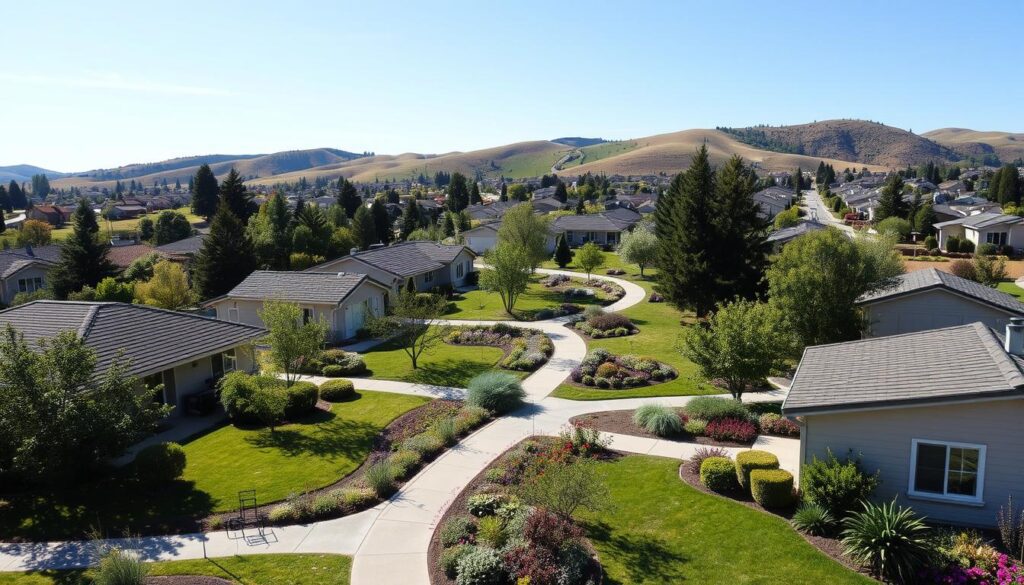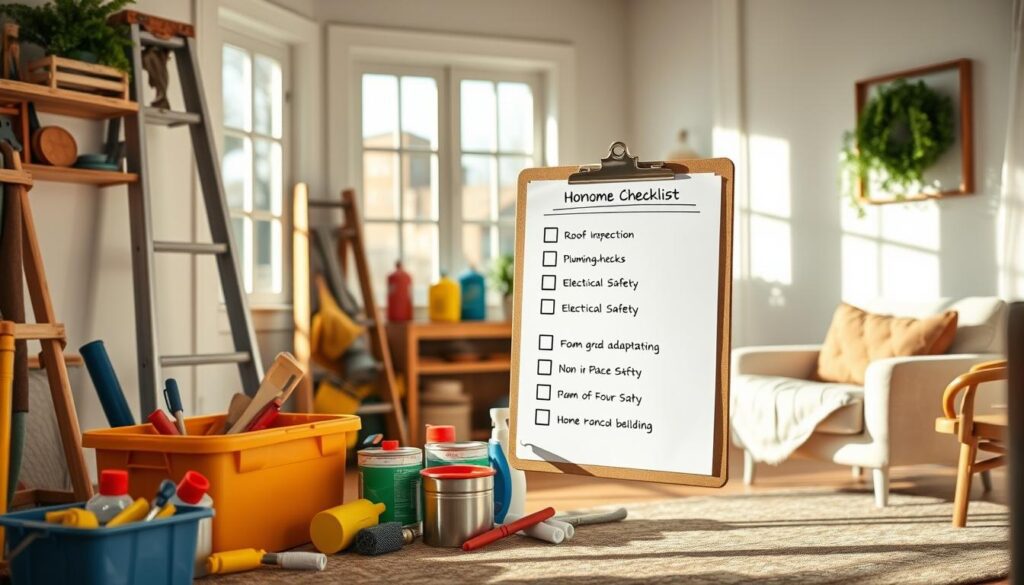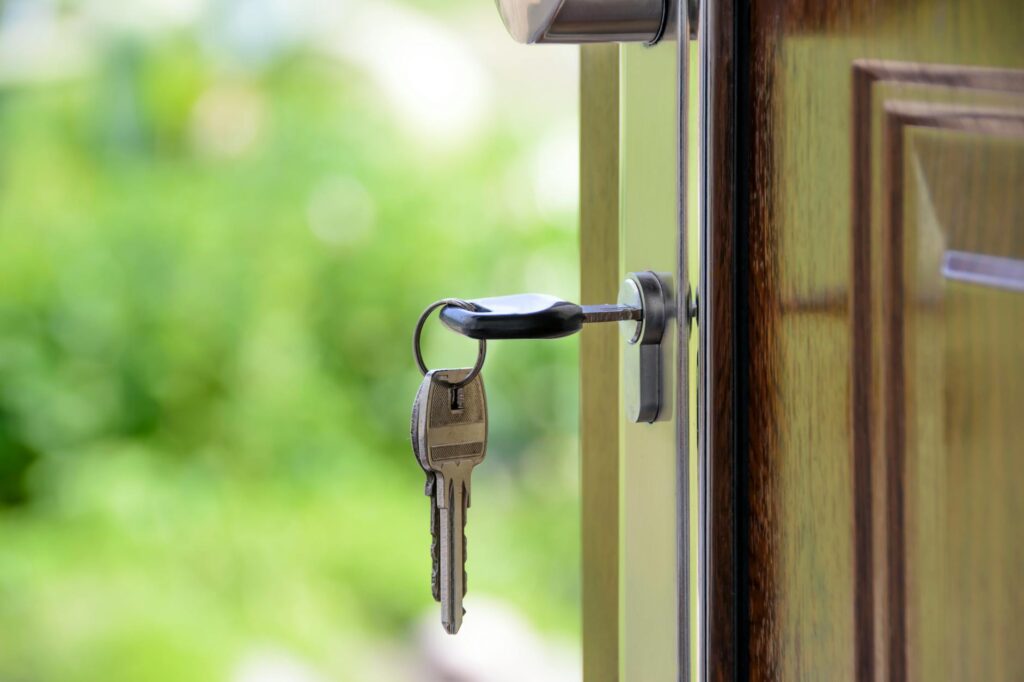Key Considerations for Home Ownership in Retirement

Home ownership is a big part of retirement planning for many Americans. You might choose to stay in your current home, downsize, or look into senior living options. Each choice depends on your financial situation, health needs, and what you want to do in retirement.
Deciding on retirement housing affects your savings, comfort, and happiness. Things like property taxes and making your home more accessible are important. This guide will help you make a home ownership plan that fits your retirement dreams.
Key Takeaways
- Evaluate how housing costs fit into your retirement budget
- Prioritize accessibility features for aging in place
- Compare downsizing benefits with emotional attachments
- Research local senior living communities and tax relief programs
- Plan for ongoing home maintenance costs during retirement
Understanding Home Ownership in Retirement: A Modern Perspective
Retirement housing trends are changing as baby boomers set new standards. Today, retirees want homes that are flexible, easy to get around, and connected to their community. Unlike before, many now see their homes as places to stay for life, not just a temporary stop before moving to assisted living.
Current Trends in Retirement Housing
Recent surveys reveal 76% of adults over 50 want to stay in their current homes. This focus on aging in place is driving demand for:
- Universal design features like zero-step entrances
- Smart home technology for safety monitoring
- Proximity to healthcare and social amenities
The Changing Landscape of Retirement Living
“The desire for independence doesn’t mean isolation. Modern retirees seek hybrid models that blend privacy with community access,” notes a 2023 AARP housing report.
Developers are now building neighborhoods with a mix of single-family homes and shared spaces. These spaces include gardens or activity centers. Companies like Brookdale Senior Living offer “continuing care” campuses. These allow residents to move between housing types as their needs change.
Impact of Housing Decisions on Retirement Quality
Housing choices greatly affect a retiree’s financial stability and daily life. A Freddie Mac study found that retirees who make smart housing choices:
- Save 15-20% on annual expenses by downsizing
- Feel 30% more connected socially
- Have fewer emergency home maintenance costs
Deciding between urban condos, suburban villas, or rural properties is crucial. It’s about finding the right balance between location and long-term health needs. The right choice can set the stage for a fulfilling retirement.
Financial Implications of Maintaining a Home During Retirement
Living in a home in retirement can be comforting but also comes with challenges. It’s important to plan for ongoing and unexpected costs. Key expenses include mortgage payments, upkeep, and property taxes. These costs can affect your financial security over time.
Retirees face several annual costs:
- Routine upkeep (lawn care, gutter cleaning)
- System replacements (HVAC, roofing)
- Emergency repairs (plumbing leaks, appliance failures)
- Property taxes (often rising with home value appreciation)
| Expense Category | Average Annual Cost | Mitigation Strategy |
|---|---|---|
| Preventive Maintenance | $2,000-$5,000 | Schedule bi-annual inspections |
| Property Taxes | $3,500+ | Apply for senior exemptions |
| Major Repairs | $10,000+ | Build dedicated savings fund |
“Retirees often underestimate cumulative housing expenses. A detailed budget accounting for inflation and aging infrastructure prevents financial strain.”
Being proactive can help manage home costs and retirement income. Many states offer tax relief for seniors, like California’s Proposition 13 and Texas’ Homestead Exemption. Upgrading to energy-efficient systems can also lower utility bills.
Here are some financial tips:
- Set aside 1-3% of your home’s value each year for maintenance
- Check your property tax assessments for errors
- Look into reverse mortgages carefully
Regularly check how much your home costs compared to your retirement income. Working with experts in aging in place or finance can help you keep your home affordable.
Evaluating Your Current Home’s Suitability for Retirement Living
Retirement means thinking about how your home meets your changing needs. You might stay for a long time or make changes. Safety features, neighborhood connections, and local support are key.
Accessibility Features and Future Needs
Homes for aging in place focus on easy movement. Important updates include:
- Wider doorways for walkers or wheelchairs
- Zero-step entrances to avoid tripping
- Lever-style door handles that are easy to use
“Proactive home accessibility updates reduce injury risks by 60% for adults over 65,” says the National Institute on Aging. Grab bars and curbless showers are safe right away. Smart home tech, like voice-activated lighting, is convenient for the future.
Location Considerations for Aging in Place
The place you live affects your independence as you get older. Walkable areas with shops, parks, and public transport are best. Look at:
- How far to healthcare providers
- If grocery delivery is available
- The quality of sidewalks and street lights
Places like Portland and Minneapolis are great for seniors. But, small towns have their own help, like volunteer drivers.
Community Resources and Support Systems
Local programs help you stay in your home. Many cities work with groups like Meals on Wheels for daily visits. See if your area has:
- Subsidized home repair services
- Senior transportation vouchers
- Free fitness classes at community centers
The AARP’s Livability Index tool checks neighborhood resources. It looks at libraries to social clubs. These help you stay connected and reduce family care needs.
Options for Home Ownership in Retirement Years
Retirement brings new housing choices that fit your changing needs. You might choose to stay, downsize, or move to senior living communities. Each option has its own benefits. Your choice depends on your finances, health, and what you want to do in retirement.
- Staying in your current home: Great if your home is easy to get around or holds special memories. Make sure you can afford upkeep costs.
- Downsizing: Smaller homes save money and effort. Many people choose condos or ranch-style homes in areas you can walk around.
- Senior living communities: Places like Brookdale or Sunrise Senior Living have gyms and healthcare right there. They help you meet people and take care of repairs and yard work.
“Retirees often overlook how housing impacts daily life. A well-chosen home supports independence while reducing stress about future needs.”
More people are choosing to live with family in retirement. This can save money and keep you company. Or, you might prefer renting a smaller place to avoid the hassle of owning a home.
Think about what you really want before making a decision. Does downsizing mean more money for travel? Can senior living communities handle your health needs as they change? Look at different places, compare costs, and talk to financial advisors to find the best fit for your retirement dreams.
Managing Property Taxes and Insurance in Retirement
Retirees often face rising costs for property taxes and insurance. These costs can strain fixed incomes. Proactive planning helps reduce these expenses while maintaining financial security.
Tax Benefits for Senior Homeowners
Many states offer exemptions or deferrals for property taxes to residents aged 65+. For example, Texas provides a homestead exemption that freezes school district taxes for qualifying seniors. Check local eligibility requirements, as income limits and application deadlines vary. Programs like California’s Property Tax Postponement allow deferring payments until the home is sold.
Insurance Considerations and Cost-Saving Strategies
Insurance for seniors often includes discounts for safety upgrades like smoke detectors or storm shutters. Bundling home and auto policies with providers like State Farm or Allstate can lower premiums. Review coverage annually to avoid overpaying for unused features. AARP members may access exclusive rates through partnered insurers.
Available Property Tax Relief Programs
Tax relief programs exist nationwide to assist retirees. Below is a summary of common options:
| Program | Eligibility | Benefit |
|---|---|---|
| Senior Freeze (NJ) | 65+, income ≤$94k | Locks tax rates |
| Circuit Breaker (IL) | 65+, income ≤$65k | Rebates up to $1k |
| Deferral (WA) | 62+, equity ≥25% | Postpone payments |
Consult a tax advisor or local assessor’s office to identify programs matching your circumstances. Reducing property taxes and optimizing insurance for seniors ensures long-term stability during retirement.
Home Maintenance and Upkeep During Golden Years

Keeping a home safe and functional is key for those aging in place. Regular maintenance prevents expensive repairs and keeps homes comfortable. Simple DIY tasks like weatherstripping windows or installing motion-sensor lights can improve safety without breaking the bank. Stores like Lowe’s and Home Depot offer discounts for seniors, making upgrades more affordable.
“Proactive home care isn’t just about fixing problems—it’s about creating spaces that adapt to changing needs over time.” – AARP Home Design Expert
Here are some steps to make upkeep easier:
- Prioritize accessibility: Replace doorknobs with lever handles, add non-slip flooring, and install grab bars in bathrooms
- Schedule seasonal checks: Inspect roofs, gutters, and HVAC systems biannually
- Build a trusted network: Partner with local services like Handyman Connection for tasks requiring professional skills
Creating a budget for home maintenance is essential in retirement. Allocate 1-3% of your home’s value annually for repairs, as HGTV’s remodeling specialists suggest. Smart devices like Nest thermostats or Ring security systems help monitor properties remotely, reducing physical strain.
For DIY enthusiasts, focus on low-impact improvements. Repainting cabinets, creating raised garden beds, or organizing storage spaces maintain home value while keeping activities manageable. Community programs like Habitat for Humanity’s Repair Corps often assist retirees with critical modifications.
By balancing personal capabilities with professional support, homes can remain joyful and safe spaces throughout retirement. Planning ahead ensures homeowners can preserve their independence while protecting their most valuable asset.
Downsizing Strategies and Their Impact on Retirement
Downsizing is key in retirement planning, offering financial relief and lifestyle changes. Moving to a smaller home can simplify daily life and align resources with long-term goals. But, it’s more than just size—it changes how retirees live their golden years.
Benefits of Downsizing in Retirement
Downsizing to a smaller space brings many benefits for retirement planning:
- Lower utility bills and property taxes
- Less time on home maintenance
- Potential equity for travel or healthcare
A study by Fidelity shows downsizers are 23% happier with their finances.
Emotional Aspects of Downsizing
Leaving a family home can be tough. Memories and belongings can make it hard to move on. Dr. Lisa Turner from AgingWell Institute says:
Downsizing is not just about space—it’s emotional. Focus on items that matter, and take time to adjust.
Talking to family and using professional organizers can help with the emotional side of downsizing.
Planning Your Downsizing Timeline
Having a plan helps avoid feeling overwhelmed:
- Start planning 2–3 years before retirement
- Declutter a room at a time over months
- Work with realtors who understand seniors
Tools like Fidelity’s Home Equity Calculator can help plan your budget for a smooth transition.
Alternative Housing Options for Retirees

Today, retirees have many housing choices. They can find places with special features and flexible living options. These options help meet financial, health, and social needs.
Senior Living Communities
Places like Brookdale and Holiday Retirement are made for older adults. They have:
- Healthcare services and wellness programs
- Social activities, fitness centers, and dining
- Maintenance-free living with no worry about repairs
These communities offer a structured life with less worry. Prices vary, but many offer plans for different budgets.
Multi-generational Housing Solutions
More families are choosing to live together to save money and support each other. Lennar’s “Next Gen” homes have private suites. Benefits include:
- Shared mortgage or rent payments
- Help with childcare or elder care
- Strong family bonds through daily life
“Living with my daughter’s family allowed me to stay active while saving on expenses. It’s a win-win for everyone.”
Rental vs Ownership in Retirement
Deciding between renting and owning depends on personal needs and finances. Here’s a comparison:
| Factor | Rental Options | Ownership |
|---|---|---|
| Monthly Costs | Predictable rent | Variable mortgage/property taxes |
| Maintenance | Landlord responsibility | Homeowner responsibility |
| Flexibility | Easier to relocate | Long-term equity growth |
Renting is good for those who value moving easily. Owning is better for those wanting stability. It’s wise to talk to a financial advisor to see what’s best for you.
Making Your Home Work for Your Retirement Income
Your home is more than a place to live. It’s a financial tool for your golden years. For retirees, using home equity or adjusting living spaces can create steady income. This way, you can enjoy your retirement without worrying about money.
Three practical ways to leverage your home:
- Reverse mortgages: Turn home equity into tax-free payments while keeping ownership. HECM loans, insured by the government, are great for homeowners 62+.
- Rent unused space: Make extra bedrooms or a basement into rental income. Airbnb makes short-term leasing easy.
- Downsize strategically: Sell a bigger home to free up equity. Then, invest the money for growth.
“A reverse mortgage isn’t a last resort—it’s a planning tool. It lets retirees access their home equity while keeping their independence.”
| Option | Key Benefit | Consideration |
|---|---|---|
| Reverse Mortgages | No monthly payments | Loan balance grows over time |
| Renting Space | Immediate income | Requires upkeep |
| Downsizing | Lump-sum cash | Emotional adjustment |
Reverse mortgages might raise questions about costs and who can get them. Talk to a HUD-approved counselor to understand the terms, fees, and long-term effects. Combining this with other income sources, like Social Security, creates a solid financial safety net.
Home equity is a big, untapped resource for retirees. Using reverse mortgages, rentals, or downsizing wisely can make your home a financial asset. This ensures your home supports your retirement dreams, not hinders them.
Conclusion: Creating Your Perfect Retirement Housing Strategy
Creating a retirement housing plan is about mixing what you need with what you want. First, check if your current home fits your future needs with tools like AARP’s HomeFit Guide. Look at things like how easy it is to get around, upkeep costs, and how close it is to doctors.
Money matters a lot in retirement living. Look into options like HUD-approved reverse mortgages or state tax breaks. FHA has special loans for seniors, and places like Brookdale Senior Living help you figure out costs.
What you like to do in your free time also plays a big role. If you love being active, consider 55+ communities. If you prefer city life, look for places close to museums and parks. Even living with family is becoming more common, thanks to HUD’s Family Unification program.
Planning ahead is key to making good choices when your health or the market changes. Use checklists from the National Council on Aging to stay on track. Keep an eye on home values with Zillow’s tools to know when it’s time to move.
Start planning now by talking to HUD-approved counselors or checking out AARP’s webinars. Your dream retirement starts with a housing plan that meets your needs and keeps you independent and secure.
FAQ
What are the current trends in retirement housing?
Retirement housing is changing. People want to stay in their homes longer and enjoy community life. Now, there are more housing choices, from single-family homes to senior living communities.
How can I evaluate my current home’s suitability for retirement living?
Check if your home is easy to get around in and if it’s in a good location. Think about the services and support nearby. As you get older, you might need a home that’s easier to move around in.
What are the options for home ownership in my retirement years?
You have many choices for home ownership in retirement. You could stay in your current home, downsize, or move to a senior community. Each option has its own benefits and drawbacks. The best choice depends on what you want and need.
How can I manage property taxes and insurance in retirement?
Property taxes and insurance can be big expenses in retirement. But, there are ways to save money. Look into tax breaks and insurance discounts. There are also programs to help with property taxes.
How do I manage home maintenance and upkeep during my golden years?
Keeping your home safe and comfortable is key in retirement. As you age, you might find it harder to do maintenance. Consider DIY projects, hiring pros, or planning for the future to keep your home in good shape.
What are the benefits and emotional aspects of downsizing in retirement?
Downsizing is a big decision that can change your life. It can save you money and make maintenance easier. But, it also means leaving behind a familiar home and adjusting to a new place.
What are the alternative housing options for retirees?
There are many housing options for retirees, like senior communities and multi-generational homes. These offer benefits like community and shared living. Think about what you want and need when deciding between renting or owning.
How can I make my home work for my retirement income?
Your home can be a valuable asset in retirement. You can use it to get money through reverse mortgages or by renting it out. Using your home to earn income can help make your retirement more secure.
